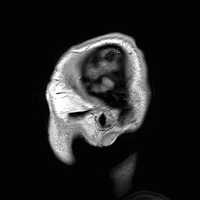Body, Soul, and the Mind/Brain Question
by Patrick Schultz
Filed under Anthropology
In addition to my recent article, “Atheism and the Personal Pronoun,” Strange Notions has featured several related pieces, “Exorcizing the Ghost from the Machine” by Matthew Allen Newland, and more recently “Exorcising Epistemology” by Matthew Becklo. True to the spirit of the Areopagus and mission of Strange Notions, these authors and I have approached the much-debated topics of the mind-brain problem and consciousness from different perspectives, arriving at subtle and nuanced conclusions.
Digital dialogue, unlike its real life, real-time analogue of face-to-face debate, can limp when it comes to clarity and expression. My intention with the first piece was to point out the limitations of reductionist materialism—the effort to reduce subjectivity, consciousness, felt-experience, etc., to the brain’s material causality and it alone, to make shine the inherent limitations of an atheistic and materially-closed universe, and thereby to beg the God question. That aside, given what’s been written by Newland and Becklo (two marvelous pieces that I thoroughly enjoyed), and Philip Lewandowski’s most recent addition on the limitations of materialism, what appears needful at this point is a more thoroughgoing presentation of the mind-brain/soul-body problem according to the Aristotelian-Thomistic perspective, which holds to a hylomorphic (“matter” and “form” together) ontology.
According to this school of thought, the foundation and starting point is nature and its characteristic motions, changes, and growths—fish swim, trees grow, humans strive. The source of this motion, or principle of change or growth, is what Aristotle called soul, the substantial form of a living being. All living beings possess souls as their substantial form: bacteria, algae, amoebas, ferns, flies, fish, dogs, horses, and human beings all have souls. On the other hand, inanimate beings such as human artifacts, be they hammers, paintings, or super computers, lack a soul (substantial form) though they do possess form.
The distinction here is between the source and kind of the form present—for living beings, the soul (substantial form) is immediately given to the being itself at the moment it comes to be (in conception); for artifacts, however, the form is imposed gradually on some matter (and this is usually done by a human, albeit animals too impose form on matter, such as beavers imposing form on streams and marshes). A pile of bricks becomes a chimney when a mason imposes chimney form onto the raw material. Contra Descartes, the human soul is not a thing separate from and then inserted into a living body nor imposed from without, like Tony Stark stepping into his Iron Man suit (as handy as that analogy was in my last article). The ethereal Casper-the-ghost connotations conjured by the word soul distorts its etymological root meaning. Soul derives from the Latin anima, meaning animation or “animate,” i.e., alive. This etymology is helpful precisely because we are far less likely to conceive of “animation” all on its own; “animation,” as a property, inheres in a living being.1
The soul (substantial form) of all living beings is that which makes the organism a substance, a living, integral, particular being. It is the principle that, from the very beginning of the organism’s existence, exercises downward causality on the matter, guiding, directing, informing the “stuff” of the thing, making it to be this substance and not that. For example, frog form (or the soul of the frog) informs froggy matter as it grows and matures from a fertilized egg, to a tadpole, and finally to a fully grown bullfrog in a way that dog form does not. Froggy soul actualizes itself in froggy matter, and doggy soul in doggy matter, each making the substance to be the whole substance that it is—from its bone structure, to the constitution of the organs, to the size, shape, and type of brain and sensory systems the organism has, etc. Although similar molecules—amino acids, proteins, carbohydrates, oxygen and carbon dioxide, etc.—are present in frogs and dogs alike, the matter of each organism as formed and as organized as a whole, integral organism is different according to the substantial form and soul of each.
Form is not merely the outward shape or contours of the thing in question; rather, form designates the essence, the what of the thing predicated. In addition, substantial form and soul cannot be reduced to DNA, as many materialistic biochemists would argue. DNA, as organized and structured matter, is itself informed and semiotic—the information that DNA bears is immaterial. It’s the difference between a Rorschach Ink block card and a newspaper page—in the first, you simply have matter (ink) unorganized; in the second you have matter (ink) organized in such a way that it bears immaterial meaning, letters combining to make words, words to make sentences, and sentences to convey meaning, none of which is in the ink on the page. These strands of nucleotide bases are themselves material, bearing an immaterial “sentence” composed of millions of “letters.”2 Dr. Leon Kass, author of The Hungry Soul, provides a concise formulation concerning the relationship between form and matter. He writes: “Form and material [matter] are, in the first instance, relative and correlative terms: Form is the something made of certain materials; materials are, as materials, materials of and for the thing as formed.”3 Form, then, is the principle of actuality in the organism causing it to be.
Physiologically, the most fundamental life process that separates animate organisms from inanimate things is the metabolic system—the taking in of nutrients for self-maintenance and energy. Metabolism is the most basic prerequisite for a being to be animated, i.e., to possess a soul. Hence, the first function of soul as the substantial form is to metabolize. Food that is “originally outside and other…must be brought inside and transformed into same.”4 What persists through time, despite the continual exchange of old stuff for new stuff on the molecular and cellular level, is precisely the form, the soul inhering in ever-new matter. Despite the continual exchange of old cells for new cells, to the point that every cell in one’s body is different than the year prior, the organism remains the same. My dog, despite having all new cells a year later, still comes when called, sits when commanded, and prefers his favorite chew toy. In a word, he is the same dog despite having a completely new cellular make-up. To this point, Msgr. Robert Sokolowski from the Catholic University of America writes, “It is not true that all the causation [in living bodies] comes from the material elements in the body…rather, in living things the matter itself is shaped and reshaped by the thing as a whole, and hence by the animation [soul] of the thing.”5 From this, we gather that the soul does not emerge as a byproduct of trillions of neurons buzzing, or chemicals ebbing and flowing, or molecules splitting and dividing, but rather it is present from the beginning, actively making the body be an integral, unified whole through time.
Therefore, although the soul can be conceived as distinct from the body, to conclude that they are in fact actually distinct is a deep intellectual error the consequences of which modernity is deeply entangled. The error consists in treating the soul as if it were a piece in the whole of the body, like an organ. The soul and the body do not form a unity of parts “placed with each other side by side, like bricks in a building.”6 The soul is not one part among many in the body. On the contrary, soul and body are united in an essential, not accidental, way so that they are “grown-together.”7 They are non-independent components of the human person that, while existing in life, are intrinsically conjoined, causally so, with the soul actualizing the whole. A part such as the liver, for example, cannot subsist on its own apart from the unified body, nor would it make sense in its own right.8 A liver only makes sense when it is seen within the larger whole.
Dualism errs in separating the body from the soul, treating the soul as a part in the body. Likewise, materialism errs by eliminating form altogether, and insisting that bare, brute matter stands alone and can account for self-identity through time and the manifest organization of a whole, integrated being. The hylomorphic view synthesizes the two positions so that the soul, or substantial form, and the body are “grown-together in the enmattered form or the informed matter that is the given thing; the dog and its flesh, the oak and its roots…are each inseparably related and…mutually interdependent.”9 Therefore, the form or soul of living organisms is not some ghostly thing residing in the body for a period of time. Nor is it merely the outside surface of the skin, and yet, this epidermal boundary is intrinsically related to and caused by the unity and wholeness achieved by the form. It is neither visible nor tangible, and yet, through the matter it informs, the soul becomes, in a sense, visible and tangible. In short, the soul, the principle of animation, is that which makes a thing to be the thing it is through time as a unified whole.
Stay tuned for Part 2 of this article on Friday.
Related Posts
Notes:
- Robert Sokolowski, Christian Faith and Human Understanding (Washington DC: Catholic University of America Press, 2006), 154. ↩
- Dr. Leon R. Kass, The Hungry Soul: Eating and the Perfecting of Our Nature (University of Chicago Press: Chicago, 1994), 43. ↩
- Kass, The Hungry Soul, 35. ↩
- Ibid., 20. ↩
- Sokolowski, Christian Faith and Human Understanding, 155-156. ↩
- Kass, The Hungry Soul, 30. ↩
- Ibid., 30. ↩
- It is only through the event of death that the soul and the body cease to be together. With the exit of the soul, the body loses integrity and begins to dis-integrate. ↩
- Kass, Hungry Soul, 35. ↩
Note: Our goal is to cultivate serious and respectful dialogue. While it's OK to disagree—even encouraged!—any snarky, offensive, or off-topic comments will be deleted. Before commenting please read the Commenting Rules and Tips. If you're having trouble commenting, read the Commenting Instructions.













